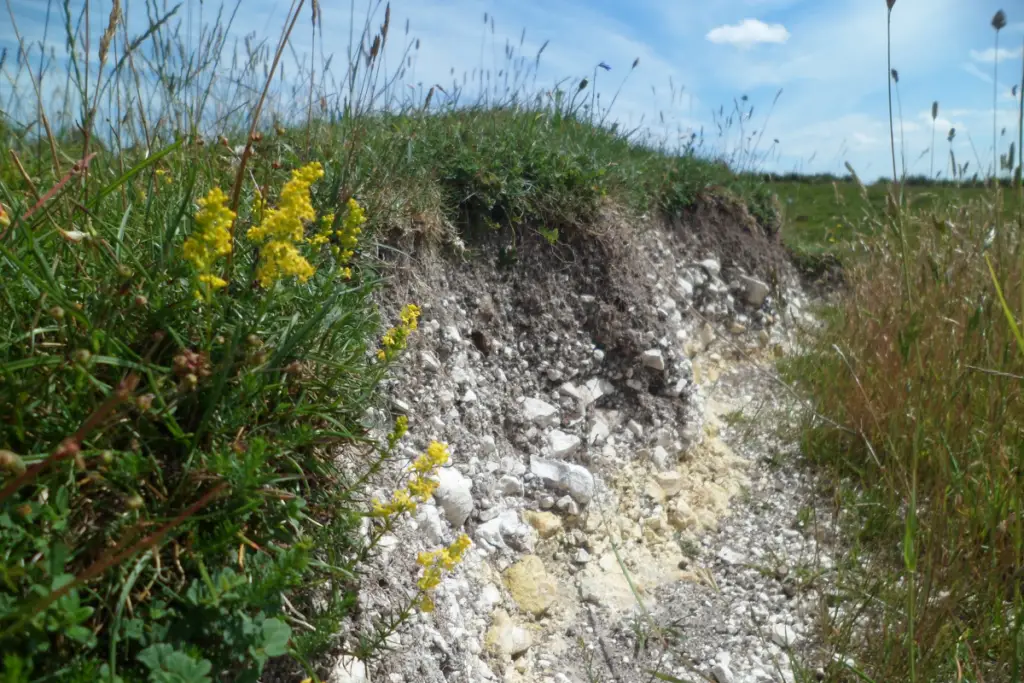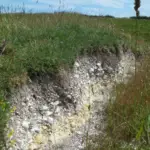Chalky soil is a type of soil that is characterized by its high pH level and low nutrient content.
It is typically found in areas with high concentrations of limestone or chalk, which are both composed of calcium carbonate.
Chalky soil is often associated with dry, arid climates, but it can also be found in areas with high rainfall.
One of the most common places to find chalky soil is in regions with limestone bedrock.
This includes areas such as the White Cliffs of Dover in England, the limestone hills of the Cotswolds, and the limestone formations of the Karst region in Slovenia.
Chalky soil can also be found in areas with high concentrations of chalk, such as the Champagne region of France, where the chalky soil is ideal for growing grapes for champagne production.
Chalky soil is not always easy to work with, as it can be difficult to cultivate and may require special attention to ensure that plants receive the nutrients they need to thrive.
However, with the right care and attention, chalky soil can be an excellent medium for growing a variety of plants, including bulbs, tubers, and flowering shrubs.

Table of Contents
Understanding Chalky Soil
Chalky soil is a type of soil that is found in areas with large deposits of chalk. It is usually shallow, stony, and dries out quickly.
This soil is alkaline with pH levels between 7.1 and 10. All chalky soils contain a lot of limestone, which makes them highly alkaline.
Chalky soil is found on top of limestone deposits deep beneath the Earth’s surface.
Therefore, it is found only in certain areas and isn’t common. Chalky soils have a stony texture and sometimes contain large, white lumps.
Many chalky soils are shallow, very free-draining, and low in fertility, but variations exist.
They are often deficient in certain nutrients, particularly nitrogen and organic matter. However, they can support a range of plants that are well adapted to these conditions.
To make the most of chalky soil, it is recommended to break up the chalk to a depth of 30in (75cm). This will encourage plants’ root systems to spread out.
As well as this, enrich the soil with lots of organic matter, such as well-rotted compost or farmyard manure.
This will add goodness and improve the soil’s ability to hold on to water so it doesn’t dry out as quickly.
Global Distribution of Chalky Soil
Chalky soil is a type of soil that is characterized by its high alkalinity and abundance of limestone. It is found in various parts of the world, but its distribution is not uniform.
Here is an overview of the global distribution of chalky soil.
Europe
Chalky soil is commonly found in Europe, particularly in the United Kingdom, France, and Germany.
In the UK, chalky soil is found in the southern and eastern parts of the country, including the South Downs, the Chilterns, and the North Downs.
It is also found in the Champagne region of France and in the Rhine Valley in Germany.
North America
Chalky soil is not as common in North America as it is in Europe, but it can still be found in some areas.
In the United States, chalky soil is found in parts of California, particularly in the Central Valley.
It is also found in some areas of the Midwest, including parts of Illinois, Indiana, and Ohio.
Asia
Chalky soil is not as prevalent in Asia as it is in Europe, but it can still be found in some areas.
In China, chalky soil is found in the Yunnan Province, which is located in the southwestern part of the country.
It is also found in some areas of India, particularly in the northern part of the country.
Australia
Chalky soil is not very common in Australia, but it can still be found in some areas.
It is found in parts of Western Australia, particularly in the Wheatbelt region. It is also found in some areas of South Australia, including the Adelaide Hills.
Chalky Soil in Europe
Chalky soil is a type of soil that is found in various parts of Europe. This type of soil is characterized by its high pH level, which is usually above 7.1.
Chalky soil is also known for being very free-draining and low in fertility. However, variations in the soil exist depending on the location.
Chalky Soil in France
Chalky soil is found in several areas of France, particularly in the northern regions.
The soil is commonly found in the Champagne region, which is known for producing high-quality sparkling wines.
The chalky soil in this region is shallow and has a high lime content, making it ideal for growing grapes.
The Loire Valley is another region in France where chalky soil is found. The soil in this region is also shallow and has a high lime content.
The chalky soil in the Loire Valley is ideal for growing grapes for wine production, as well as for growing other crops such as cherries and apples.
Chalky Soil in England
Chalky soil is commonly found in England, particularly in the southern regions.
The most famous example of chalky soil in England is the White Cliffs of Dover, which are made up of pure white chalk.
The chalky soil in this region is also ideal for growing crops such as wheat and barley.
The South Downs is another region in England where chalky soil is found.
The soil in this region is shallow and has a high lime content, making it ideal for growing crops such as grapes and hops for beer production.
The chalky soil in the South Downs is also home to several rare plant and animal species, including the Adonis blue butterfly and the chalkhill blue butterfly.
Chalky Soil in North America
Chalky soil is a type of soil that is rich in calcium carbonate. It is typically alkaline and has a stony texture.
Chalky soil is not very common in North America, but it can be found in certain areas of the United States and Canada.
Chalky Soil in United States
Chalky soil is found in various regions of the United States, particularly in the Midwest and Great Plains regions.
The soil is typically found in areas where there are limestone and chalk deposits. Some of the states where chalky soil can be found include:
- Texas
- Kansas
- Nebraska
- Iowa
- Illinois
- Indiana
- Ohio
In the United States, chalky soil can cause nutrient deficiencies in plants, particularly iron and manganese.
However, it is also known to produce some crops with high yields, such as wheat, corn, and soybeans.
Chalky Soil in Canada
Chalky soil is not as common in Canada as it is in the United States. However, it can still be found in certain regions of the country.
Chalky soil is typically found in areas where there are limestone and chalk deposits.
Some of the regions where chalky soil can be found include:
- Southern Ontario
- Quebec
- Manitoba
- Saskatchewan
In Canada, chalky soil can be a challenge for farmers, as it can cause nutrient deficiencies in plants. However, with the right management practices, it is possible to grow crops successfully in chalky soil.
One of the ways to do this is by adding organic matter to the soil, which can help to improve its ability to hold water and nutrients.
Chalky Soil in Asia
Chalky soil is found in various parts of Asia, including China and India.
Chalky Soil in China
Chalky soil is commonly found in the southern regions of China, particularly in the provinces of Guangdong, Guangxi, Yunnan, and Guizhou.
These areas have a warm and humid climate, which is conducive to the formation of chalky soil.
Chalky soil in China is characterized by its high alkalinity and low nutrient content.
As a result, it can be challenging to grow certain types of plants in these areas. However, some crops, such as tea, do well in chalky soil.
Chalky Soil in India
Chalky soil is found in various parts of India, including the states of Uttar Pradesh, Bihar, and Madhya Pradesh.
These areas are located in the northern part of the country and have a warm and dry climate.
Chalky soil in India is characterized by its high calcium carbonate content, which makes it highly alkaline.
This type of soil can be challenging to cultivate, as it tends to be low in nutrients and can cause nutrient deficiencies in plants.
However, some crops, such as wheat and mustard, can grow well in chalky soil.
Chalky Soil in Australia
Chalky soil is a type of soil that is commonly found in certain areas of Australia.
This type of soil is characterized by its high alkalinity, which can make it difficult for plants to grow. However, there are ways to work with chalky soil and improve its fertility.
Characteristics of Chalky Soil in Australia
Chalky soil is typically found in areas with limestone deposits, which are common in certain parts of Australia.
This type of soil is known for its high pH level, which can range from 7.1 to 8.5.
Chalky soil is also characterized by its high calcium content, which can make it difficult for plants to absorb other nutrients.
In addition to its high alkalinity, chalky soil is often lumpy and stony, which can make it difficult to work with. However, with proper soil preparation and management, gardeners can improve the fertility of chalky soil and grow a variety of plants.
Plants that Thrive in Chalky Soil
While chalky soil can be challenging to work with, there are many plants that thrive in this type of soil.
Some examples of plants that do well in chalky soil include:
- Lavender
- Rosemary
- Thyme
- Sage
- Yarrow
- Sedum
- Stonecrop
- Honeysuckle
These plants are adapted to the high pH and calcium content of chalky soil and can grow well with minimal soil amendments.
Improving Chalky Soil Fertility
To improve the fertility of chalky soil, gardeners can add organic matter such as compost or manure.
This can help to balance the pH level of the soil and provide additional nutrients for plants.
Additionally, adding mulch to the soil can help to retain moisture and prevent erosion.
Another option for improving the fertility of chalky soil is to use fertilizers that are specifically formulated for alkaline soils.
These fertilizers can provide the necessary nutrients for plants to grow and thrive in chalky soil.
Chalky Soil in Africa
Chalky soil is a type of soil that is rich in calcium carbonate. It is known to be alkaline and has a pH level between 7.1 and 10.
This type of soil is usually shallow, stony, and dries out quickly. In Africa, chalky soil is found in various regions.
According to a report by Leenaars, J. et al. (2021), some parts of Sub-Saharan Africa have chalky soils.
The report states that the soil profiles in Africa have been compiled into a database that includes georeferenced and standardized legacy soil profile data.
This database can be used to map African soil properties and nutrients at a 30-meter spatial resolution.
Chalky soil is commonly found in the northern and northwestern regions of Africa, particularly in Morocco, Algeria, Tunisia, and Libya.
These countries have a Mediterranean climate, which is characterized by hot, dry summers and mild, rainy winters.
The combination of warm temperatures and low rainfall contributes to the formation of chalky soil.
In addition to the Mediterranean region, chalky soil can also be found in other parts of Africa. For example, in South Africa, there are areas with chalky soil that are suitable for growing grapes.
The Western Cape region, in particular, has a Mediterranean climate that is similar to that of the northern African countries mentioned above.
Factors Influencing Chalky Soil Distribution
Chalky soil is a type of soil that is formed from the accumulation of calcium carbonate in the soil. It is usually alkaline and has a high pH level.
Chalky soil is found in various parts of the world, but its distribution is influenced by several factors.
Parent Material
The parent material is the type of rock or sediment from which the soil is formed.
Chalky soil is formed from the accumulation of calcium carbonate, which is derived from the shells of marine organisms.
Therefore, areas that were once covered by oceans or seas are more likely to have chalky soil.
For example, chalky soil is commonly found in the southern and eastern parts of England, which were once covered by the Chalk Formation.
Climate
Climate plays a significant role in the distribution of chalky soil. Chalky soil is usually found in areas with a dry and warm climate.
This is because the accumulation of calcium carbonate requires a warm and dry environment. For example, chalky soil is commonly found in the Mediterranean region, which has a warm and dry climate.
Topography
Topography refers to the physical features of the land, such as its elevation and slope. Chalky soil is usually found at higher elevations and on slopes.
This is because the accumulation of calcium carbonate requires good drainage, which is provided by the steep slopes. For example, chalky soil is commonly found on the hills and mountains of the Mediterranean region.
Time
The formation of chalky soil takes a long time, usually thousands of years.
Therefore, areas that have been dry and warm for a long time are more likely to have chalky soil. For example, chalky soil is commonly found in areas that were once covered by the Tethys Sea, which existed during the Mesozoic Era.
Vegetation
Vegetation also plays a role in the distribution of chalky soil. Chalky soil is usually found in areas with low vegetation cover.
This is because the alkaline nature of chalky soil can be toxic to some plants. For example, chalky soil is commonly found in areas with grasslands and shrublands.
Conclusion
Chalky soils are predominantly found in areas with underlying chalk or limestone rock formations.
These soils have a high pH level, typically above 7.1, and are characterized by their free-draining nature.
Chalky soils can be shallow and prone to drought, making them unsuitable for certain types of plants.
Despite their limitations, chalky soils can be productive if managed properly.
Gardeners can improve the soil by breaking up the chalk to a depth of at least 30 inches and enriching it with organic matter such as well-rotted compost or farmyard manure.
This will help to improve the soil’s ability to hold onto water, preventing it from drying out too quickly.
Calcicoles, or lime-loving plants, are well-suited to chalky soils and can thrive in these conditions.
Examples of calcicoles include Syringa and Lavender. However, calcifuges, or lime-hating plants, will struggle to grow in chalky soils. Examples of calcifuges include Rhododendrons and Azaleas.
- How to Dry Basil Leaves: A Professional Guide
- Is an Avocado a Fruit or Vegetable? Simple Answer and Explanation
- Does Pineapple Have Seeds? Exploring the Anatomy of Pineapples
- Blooming Through Winter: Can I Grow Vegetables Indoors in the Winter?
- What Can You Grow in a Greenhouse All Year Round: A Guide to Year-Round Greenhouse Gardening
- Are Blueberries Blue? Debunking the Myth of Their Color
















